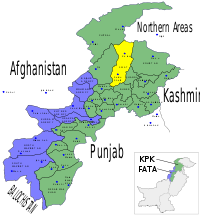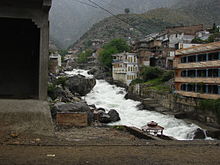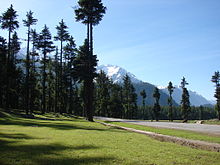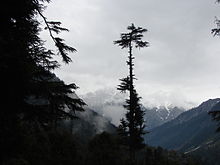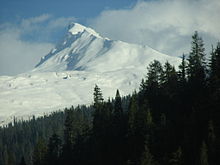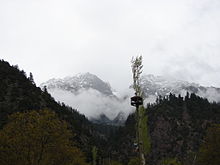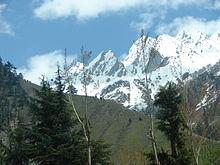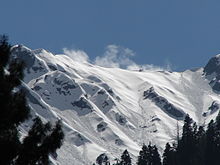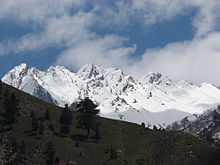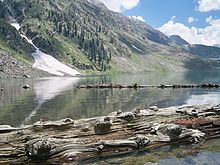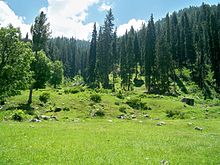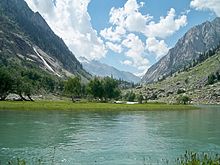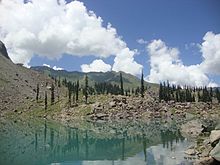- Swat, Pakistan
-
Swat District
سوات— District — Location of Swat District (highlighted in yellow) within the Khyber-Pakhtunkhwa Province of Pakistan. Country  Pakistan
PakistanProvince Khyber Pakhtunkhwa Province Capital Saidu Sharif Established Government – District Nazim – District Naib Nazim Area – Total 5,337 km2 (2,060.6 sq mi) Population (1998) – Total 1,257,602 – Density 236/km2 (611.2/sq mi) Time zone PST (UTC+5) Area code(s) Area code 946 District Council Website "www.swatdirectory.com" "www.tourswat.com" Swat (pronounced [ˈsʋaːt̪], Pashto: سوات) is a valley and an administrative district in the Khyber Pakhtunkhwa Province, located close to the Afghan-Pakistan border. It is the upper valley of the Swat River, which rises in the Hindu Kush range. The capital of Swat is Saidu Sharif, but the main town in the Swat valley is Mingora.[1] It was a princely state (see Swat (princely state)) in Khyber Pakhtunkhwa until it was dissolved in 1969. The valley is almost entirely populated by ethnic Pashtuns . The language spoken in the valley is Pashto/Pakhto. With high mountains, green meadows, and clear lakes, it is a place of great natural beauty and is popular with tourists as "the Switzerland of Pakistan".
Contents
History
The names found in ancient Indian sources for Swat are Udyana and Suvastu because of the scenic beauty of the valley and the name of the river respectively - although those names were foreign terms not used in the region. Swat has been inhabited for over two thousand years. The first inhabitants were settled in well-planned towns. In 327 BC, Alexander the Great fought his way to Udegram and Barikot and stormed their battlements. In Greek accounts these towns have been identified as Ora and Bazira. Around the 2nd century BC, the area was occupied by Buddhists, who were attracted by the peace and serenity of the land. There are many remains that testify to their skills as sculptors and architects. In the beginning of the 8th century AD, Gabari Royal Tajik tribe advanced through Laghmanat, ningarhar, Dir and invaded Swat, defeating the Bhudist and hindus.This war was headed by Sultan Pakhal Gabari and later on by Sultan Behram Gabari Rulers of Kuner Pich and cousin of Rulers of Balkh and Kashmir. Later some Dilazak encrouched tha area and settled among Gabaris, who in turn were ousted by the Yusufzais which was backed by Mughal Badshah Zahiruddin Muhammad Baber then the super power in 1519 and 1520.This is the historical paradox that The Yusufzais were ousted from Kabul by Mirza Ullegh beg the uncle of Baber and killed 600 malak of Yusufzai where as the Gabaris helped Yousofzais refugees with warm wellcom and settle them in their areas bajour dir and swat and the Yousofzais forgot the generasity of Gabaris and encrouched the Gabari state with the plotted help of Zahiruddin Muhammad babar and Demolished the Gabar-Kot (fortress) in bajour in 1519 and further advanced to the swat and compel the last Gabari King Sultan Awais Gabari to flee to Upper Dir and established his rule in Upper dir,Chitral wakhan,Badakhshan and other upper Oxus pretty states. The originator of the present family of Swat was the Muslim saint Abdul Ghafoor, the Akhund of Swat, a Safi Momand of Hazara district, from where he went to Buner territory. He was a pious man and the people respected him so greatly that they called him AKHUND SAHIB.[2]
It was the mid-19th century when Muslim tribes were fighting against each other for the possession of Swat Valley. On the intervention of the honourable Akhund Sahib, the killing was stopped, and such was his influence that the chiefs of all tribes unanimously made him the ruler of the valley. Akhund Sahib administrated the valley according to Muslim laws. Peace and tranquility prevailed, and agriculture and trade flourished in the territory. Akhund Sahib had two sons by his wife, who belonged to Nikbi Khel.
After the death of Akhund Sahib, the tribal chiefs again started fighting and killing, which continued for years. Eventually the tribal chiefs agreed to give the control of the valley into the hands of the honourable Gul Shahzada Abdul Wadood, the son of Mian Gul Abdul Khaliq, son of Akhund Sahib. The wife of Mian Abdul Wadood was the daughter of Honorable Mirza Afzal-ul-Mulk, the ruler of Chitral. The British by trick put Chitral under the suzerainty of Kashmir. The Chitral ruler gave two horses every year to the Rajia of Kashmir, and the Raja provided Chitral with grain and sugar, etc. Swat thus went under protection of the British.
During the rule of Mian Gul Muhammad, Abdul Haq Jehanzeb, the son of Mian Abdul Wadood, the state acceded to Pakistan in 1947. The present prince, Muhammad Aurzngzeb Khan, son of Jahanzeb, married the daughter of Field Marshal Mohammad Ayub Khan in 1955. Jahznzeb started a Degree College at Saidu Sahrif, the capital of the State, and four High Schools at Mingora, Chakesar, Matta and Dagar. Fourteen middle schools, twenty-eight lower middle schools, and fifty-six primary schools were established. A girls high school and high class religious schools were established at Saidu Sharif. At all the schools, the poor students were granted scholarships. The state was an exemplary state during British rule. The minority Gujjars were very poor people in the Swat Valley, but nowadays they have diverted their attention towards education and are holding good posts in government services.
The current Prince Aurangzeb Khan was also Governor of Baluchistan.
Buddhist heritage of Swat
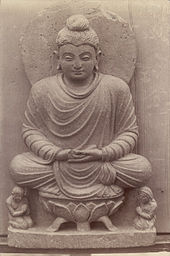 An 1869 photo of a Buddha statue seated on a lotus throne in the Swat Valley.
An 1869 photo of a Buddha statue seated on a lotus throne in the Swat Valley.
Although it is generally accepted that Tantric Buddhism first developed in Swat under King Indrabhuti, there is an old and well-known scholarly dispute as to whether Uddiyana was in the Swat valley, Orissa or some other place.Padmasambhava (flourished eighth century AD), also called Guru Rimpoche, Tibetan Slob-dpon (teacher), or Padma ‘byung-gnas (lotus born) legendary Indian Buddhistic Mystic who introduced Tantric Buddhism to Tibet and is credited with establishing the first buddhist monastery there.According to tradition, Padmasambhava was native to Udyana (now Swat in Pakistan).[3] Padmasambhava was the son of Indrabhuti, king of Swat in the early eighth century AD. One of the original Siddhas, Indrabhuti flourished in the early eighth century AD and was the king of Uddiyana in the Kabul valley. His son Padmasambhava is revered as the second Buddha in Tibet. Indrabhuti's sister, Lakshminkaradevi, was also an accomplished siddha of the 9th century AD.[4] Ancient Gandhara, the valley of Pekhawar, with the adjacent hilly regions of Swat and Buner, Dir and Bajaur was one of the earliest centers of Buddhist religion and culture following the reign of the Mauryan emperor Ashoka, in the third century BC. The name Gandhara first occurs in the Rigveda which is usually identified with the region[5]
The Swat museum has acquired footprints of the Buddha, which were originally placed for devotion in the sacred Swat valley. When the Buddha ascended, relics (personal items, body parts, ashes etc.) were distributed to seven kings, who built stupas over them for veneration.
The Harmarajika stupa (Taxila) and Butkarha (Swat) stupa at Jamal Garha were among the earliest Gandhara stupas. These were erected on the orders of King Ashoka and contained the genuine relics of the historic Buddha.[citation needed]
The Gandhara school is credited with the first representations of the Buddha in human form, rather symbolically as the wheel of the law, the tree, etc.[citation needed]
As Buddhist art developed and spread outside Gandhara, Gandharan styles were imitated. In China the Gandhara style was imitated in bronze images, with gradual changes in the features of these images over the passage of time. Swat, the land of romance and beauty, is celebrated throughout the Buddhist world as the holy land of Buddhist learning and piety. Swat was a popular destination for Buddhist pilgrims. Buddhist tradition holds that Buddha himself came to Swat during his incarnation as Gautama Buddha and preached to the people here.
It is said[by whom?] that the Swat valley was filled with fourteen hundred imposing and beautiful stupas and monasteries, which housed as many as 6,000 gold images of the Buddhist pantheon for worship and education. Archaeologists now know of more than 400 Buddhist sites covering an area of 160 km2 in Swat valley alone. Among the important excavations of Buddhist sites in Swat an important one is Butkarha-I, containing original relics of the Buddha. A stone statue of Buddha, is still there in the village Ghalegay.[citation needed] There is also a big stupa in Mohallah Singardar Ghalegay.[citation needed]
Hindu Shahi Rulers and Sanskrit
Swat was ruled by the Hindu Shahi dynasty who have built an extensive array of temples and other architectural buildings now in ruins. Sanskrit may have been the lingua franca of the Swatis.[6]
Hindu Shahi rulers built fortresses to guard and tax the commerce through this area. Their ruins can be seen in the hills of Swat: at Malakand pass at Swat’s southern entrance.[7]
Advent of Islam by Mahmud of Ghazni
At the end of the Mauryan period (324-185 BC) Buddhism spread in the whole Swat valley, which became a very famous center of Buddhist religion.[8]
After a Buddhist phase the Hindu religion reasserted itself, so that at the time of the Muslim conquest (AD1000) the population was solidly Hindu.[8]
In 1023 Mahmood of Ghazni attacked Swat and crushed the last Buddhist King, Raja Gira in battle. The invasion of Mahmood of Ghazni is of special importance because of the introduction of Islam as well as changing the Chronology.[9]
Arrival Of Yousafzais
The first Muslim arrivals in Swat were Pakhtun Dilazak tribes from south-east Afghanistan. These were later ousted by Swati Pakhtuns, who were succeeded in the sixteenth century by Yusufzai Pakhtuns. Both groups of Pakhtuns came from the Kabul valley.[8]
Geography
The valley of Swat is situated in the north of N.W.F.P, 35° North Latitude and 72° and 30° East Longitude, and is enclosed by the sky-high mountains.
Chitral and Gilgit are situated in the north, Dir in the west, and Mardan in the south, while Indus separates it from Hazara in the east. Physical Features: Swat can be divided into two physical regions:
- Mountainous Ranges.
- Plains.
Mountainous Ranges
As mentioned above, Swat is lying in the lap of Mountainous Ranges, which are the offshoots of Hindukush, so the larger part of Swat is covered with high mountains and hills, the crests of which is hidden by everlasting snow. Though these gigantic Ranges run irregularly: some to the west while the others to the east, but the general direction is North-South. These ranges enclose small but very enchanting valleys.
Eastern Ranges: In Kohistan-e-Swat the chief knot of eastern ranges is Mankial. Its northern branches separate Kohistan-e-Swat from Abasin Kohistan. These ranges form a barrier between Gilgit and Swat, and between Chitral and Swat. The southern extension of Mankial ranges reaches proper Swat. There they join Shangla ranges. Shangla ranges separate proper Swat from Shangla Par area (Shangla Par district). In Shangla district, there are Karora Ranges, which separate Puran from Kanra and Ghurband. The continuation of Shangla ranges joins Dwasaray. On the one hand Dwasaray separates lower Swat from Puran, on the other, it set aside the Buner from Puran. Now the general Direction of the ranges turns westward. Here it is called Elum. Elum Ranges is a big wall between the proper Swat and Buner. The Elum ranges at last join mountains of Malakand.
The Western Ranges: Western ranges start from the mountain and hills of Gabral, Kohistan-e-Swat. It joins the hills of Kundal (Utror). There these ranges meet Daral Ranges. These ranges form a border with Dir district. They run west ward and are named according to the locality. For example Lalko ranges Manrai and Chaprai etc. at last they join the hills of Adenzee and Shamozee. Manrai ranges send off some off shoots southward. They the hills separate Arnoyay valley from the widest valley of Nekpikheil valley.Plains
Actually the valley of Swat starts from the foothill of Malakand but we are concerned with portion from Landakay to Gabral (Gulabad), the area within the administrative boundaries of Swat. The length of the valley from Landakay to Gabral is 91 miles. Two narrow strips of plains run along the banks of Swat River from Landakay to Madyan. Beyond Madyan in Kohistan-e-Swat, the plan is too little to be mentioned. So for as the width concerns, it is not similar, it varies from place to place. We can say that the average width is 5 miles. The widest portion of the valley is between Barikot and Khwazakheila. The widest view point and the charming sight where a major portion of the valley is seen is at Gulibagh on main road, which leads to Madyan. There are some subsidiary valleys, which help to increase the width of the main valley. These subsidiary valleys are called "Daras". A Dara a narrow passage between mountains, and sometimes, the upper course of a river is also called Dara. If we imagine the main valley as a stem of a tree the subsidiary valleys form its branches. Swat River and its tributaries drain Swat. There fore, the whole valley is the outcome of running water. This flowing water cuts the upper courses deeply, and flows the load of washed away materials. As the gradient is greater in the upper course so the erosion is on large scale, particularly in the summer rains, when all the rivers are in flood. The big boulders and stones are rolled, which causes more destruction in the upper courses. When the loaded water reaches to the areas of low gradient, the heavier materials are deposited. The deposition takes place according to the slope, generally, we observe, that the upper course is made up of big boulders, the middle course is of relatively small stones, pebbles, and debris, while the lower course is made of fine clay. Anyhow, the whole plain of Swat valley is strewn by the running water, and is made up of fine alluvial soil.
Demographics
The population at the 1981 Census was 715,938, which had risen to 1,257,602 at the next Census in 1998. The main language of the area is Pakhto. The people of Swat are mainly Pakhtuns, Yusufzais, Akhund Khel Miangan (Syed), Chitralis, Kohistan is, Gurjar (Gujar or Gurjar is the major tribe of the district; its people are divided in different clans like Khatana, Bajarh, Chichi, Ahir, Chuhan, Pamra, Gangal etc. are the main subtribe of the Gurjar family of Swat), Akhund khel Yousafzai, Nooristani, and Awans. Most probably they are originated from the same tribe that roamed around the great trans-Himalayan mountain ranges thousands of years before, and now remained in some isolated pockets of the Himalayan mountain ranges.[citation needed]
The Dardic people of the Kalam region in northern Swat are known as Kohistan is and speak the Torwali and Kalami languages. There are also some Khowar speakers in the Kalam region. This is because before Kalam came under the rule of Swat, it was a regional tributary to Chitral. The Kalamis paid a tribute of mountain ponies to the Mehtar of Chitral every year.
Tourist attractions
Marghazar
Marghazar 16 km away from Saidu Sharif is famous for its “Sufed Mahal” the white marble palace of the former Wali (Ruler) of Swat.
Malam Jabba
 PTDC Motel at Malam Jabba Ski Resort
PTDC Motel at Malam Jabba Ski Resort
Malam Jabba (also Maalam Jabba, Urdu: مالم جبہ) is a Hill Station in the Karakoram mountain range nearly 40 km from Saidu Sharif in Swat Valley, Peshawar, Pakistan. It is 314 km from Islamabad and 51 km from Saidu Sharif Airport.Malam Jabba is home to the largest ski resort in Pakistan.The Malam Jabba Ski Resort, owned by the Pakistani Tourism Development Corporation, had a ski slope of about 800m with the highest point of the slope 2804 m (9200 ft) above sea level. Malam Jabba Ski Resort was the joint effort of the Pakistan government with its Austrian counterpart. The resort was equipped with modern facilities including roller/ice-skating rinks, chair lifts, skiing platforms, telephones and snow clearing equipment.
Swat Museum
Swat Museum is on the east side of the street, halfway between Mingora and Saidu. Japanese aid has given a facelift to its seven galleries which now contain an excellent collection of Gandhara sculptures taken from some of the Buddhist sites in Swat, rearranged and labelled to illustrate the Buddha's life story. Terracotta figurines and utensils, beads, precious stones, coins, weapons and various metal objects illustrate daily life in Gandhara. The ethnographic section displays the finest examples of local embroidery, carved wood and tribal jewellery. For the last three years the museum is occupied by Pakistan army and it is not known when they would be leaving it.
Miandam
Miandam is a small summer resort ten kilometres (six miles) up a steep side valley and 56 kilometers (35 mi) from Saidu Sharif, making it an hour's drive. The metaled road passes small villages stacked up the hillside, the roofs of one row of houses forming the street for the row of houses above. Tiny terraced fields march up the hillside right to the top. Miandam is a good place for walkers. Paths follow the stream, past houses with behives set into the walls and good-luck charms whitewashed around the doors. In the graveyards are carved wooden grave posts with floral designs, like those used by Buddhists 1,000 years ago.
Madyan
By the time you reach this small town at 1320 m and about 60 km from Mingora, the mountains have closed in and the valley is almost snug. Here one senses why Swat is so popular among the tourists. There are a lot of embroidered shawls in the Bazars of Madyan.At 1,321 metres (4,335 feet) above sea level,but it is a larger town and has many hotels in all price ranges and some good tourist shopping. Antique and modern shawls, traditional embroidery, tribal jewellery, carved wood and antique or reproduced coins are sold along the main street. This is the last Swati village, offering interesting two-and three-day walks up to the mountain villages... ask in the bazaar in Muambar Khan's shop for a guide. North of Madyan is Swat Kohistan where walking is not recommended without an armed guard. The central mosque at Madyan has carved wooden pillars with elegant scroll capitals, and its mud-plastered west wall is covered with relief designs in floral motifs. Both bespeak the Swati's love of decoration.For forieng tourest on can help from the link http://www.madyanguesthouse.com which is owned by Murad Ali Khan
Behrain
Bahrain, Swat valley
A quarter of an hour past Madyan, the road squeezes through Behrain. Tourists stop to shop or have a look around for beautiful carved wood chairs and tables and other handicrafts. Behrainis are a mix of Pashtuns and Kohistanis. Behrain is ten kilometres north of Madyan and only slightly higher, at about 1,400 metres (4,500 feet). It is another popular riverside tourist resort, with bazaars worth exploring for their handicrafts. Some of the houses have carved wooden doors, pillars and balconies. These show a remarkable variety of decorative motifs, including floral scrolls and bands of ornamental diaper patterns almost identical to those seen on Buddhist shrines and quite different from the usual Muslim designs.
Kalam
Kalam, Swat valley Kalam, Swat valley
Kalam, Swat valley
2070 m high and 100 km from Mingora, it was the centre of an independent state in the 19th century. It was later taken by Chitral then given to Swat after partition.Kalam, 29 kilometres (18 mi) from Bahrain and about 2,000 metres (6,800 feet) above sea level, the valley opens out, providing rooms for a small but fertile plateau above the river. In Kalam the Ushu and Utrot rivers join to form the Swat river. Here, the metalled road ends and shingle road leads to the Ushu and Utrot valleys. From Matiltan one gets a breath-taking view of the snow-capped Mount Falaksir 5918 metres (19,415 ft.), and another un-named peak 6096 metres (20,000 ft.) high.
Usho
Usho 3 km from Kalam Valley and 117 km from Saidu Sharif
Utror
Utror, Swat Valley Utror, Swat valley
Utror, Swat valley
Utror 16 km from Kalam Valley and 120 km from Saidu Sharif.Utror valley is situated between 35° 20′ to 35° 48′ N latitudes and 72° 12′ and 72° 32′ E longitudes. The population of Utror is 6888 and the area of the valley is about 47400 hectares. Utror valley is surrounded by Gabral and Bhan valleys on the east, upper Dir district on the west, Kalam valley on the south and Gabral valley on the north. It is 15 km from Kalam, the centre of Swat Kohistan. The altitude of the valley at Utror proper is 2300 meters and reaches to 2900 meters at Kandol Lake.
Ghabral
Gabral valley lies between 35° 20′ to 35° 48′ N latitudes and 72° 12′ and 72° 32′ E longitudes over an area of about 38733 hectares. The population of Gabral is 3238. The valley is surrounded by Chitral District in the north, Utror valley in the south and south west, upper Dir district in the west and Bhan and Mahodand valleys in the east. It is 5 km distant from Utror proper and 20 km from Kalam. The altitude of the valley ranges from 2580 metres at Baila to 5160 metres at Karkaray Lake top.In Utror and Gabral, 44 medicinal plants are collected during the months of May, June, July and August. Only 14 of them are traded to National and International markets while the rest are used locally. A survey by Pakistan Forest Institute concludes that 75 crude herbal drugs are extensively exported and more than 200 are locally traded in Pakistan. Indigenous people, who have no training in sustainable harvesting, post-harvesting care and storing of medicinal plants, collect 85 percent of these crude herbs from the wild.
Kundol Lake, Swat valley Kundol Lake, Swat valley
Kundol Lake, Swat valley
Mahudan
Mahodand valley, which lies in the North of Kalam, is famous not only among nature lovers, and escapists but also the exotic trout fish hunters. The valley can be accessed through an un-metalled road from Kalam in a four by four (4x4) vehicle. The road is bumpy and tricky but the surrounding landscapes engrosses you so severely that you wish for more and expect to discover new panoramas. The small hamlets that are scattered in the mountains and the bellowing smoke that spirals into the sky from the houses are some, which lives in the memory forever. Swat River, which is born here, is shackled by the tall mountains, which has turned its water into a roaring monster trying to release itself from its fetters, but there are some places where the river is calm and silent without showing any sign of rebellion.
Pari (Khapiro) lake
Pari Lake is one of the lakes in Swat region which is located at a very high altitude in the foot of the tallest peak in the range with a considerable depth. The name Pari or Khapiro is given to the lake due to the widespread belief that the lake is the abode of fairies where they live and bathe in the cool, pure and clear water of the lake. It is located to North-east of Utror valley and can be accessed only by trekking. Trekking to the lake needs endurance and love for nature as the trail is exasperating as well as dangerous therefore, utmost care should be taken while trekking on the narrow bends and turns leading to the lake. The lake is accessible from both Izmis and Kundal lakes. Two ascending tracks lead to this lake from Kundal and Izmis lakes taking almost five hours to reach this roof top of Swat. The trail is very steep from both sides but the surrounding beauty and eye-cooling green pastures and exotic flowers not only boost the trekker’s stamina but compel him to explore further.
Kundol Lake
The pastoral valley of Swat has abundance of precious resorts of nature where one can find solace and respite from the never-ending struggle of life. Kundal or Kandolo Lake is one such place here upon which the Maestro of nature has spent extra time and effort to paint. Kundal Lake is situated in the north of Utror valley. One can easily access it from Kalam via Utror from where a link road ends in a green valley called Ladu in the foothills of the lake. You can either hike to Ladu from Utror or take a four-wheeler to ease and minimize your journey. It consumes almost two hours to reach the beautiful valley of Ladu. For the adventurous kind, a walk in the romantic valley will unravel several new mysteries. The people who take temporary residency over here during summer plow the open land and harvest potatoes and turnips, which are famous all over the country for its exotic taste. There is also a small hut in Ladu where you can take tea and get something for eating. From Ladu it takes almost four hours to reach the lake. Some locals can guide you and even take your luggage if properly paid. The mountains around this small valley are covered with tall cedar and pine trees and meandered by different streams and torrents. The people are friendly and provide you guidance if required.
Bashigram Lake
Bashigram Lake is situated to the east of Bashigram valley near Madyan. The road to this valley is partly metaled and can be plied by a four by four or any ordinary vehicle. It takes almost forty to fifty minutes to reach this picturesque valley inhibited by simple and hospitable folk. From here, trekking of four to five hours, depending on professionalism and enthusiasm of the trekkers lands you in the realm of a serene and enchanting lake of Bashigram.
Spin Khwar (White Stream) Lake
Spin Khwar is a beautiful lake hidden in the lap of mountains towards the north of Kundal Lake and east of Utror valley. The name Spin Khwar has a clear significance as a small white stream in the east flows down to the lake from the surrounding mountains and is a major source of water for the lake. The lake is accessible through two tracks, one from Kundal and the other from Ladu valley. The track from Ladu is comparatively easy to walk and less tiring while the track from Kundal is not only difficult but alarmingly dangerous although it is short and links Kundal and Spin Khwar. Its steepness and dangerous bends needs an experienced trekker and unending physical strength. The grazers in the area have built small huts and a mosque where one can stay but a personal tent is more recommendable as these huts are in a poor condition due to lack of maintenance.
Daral Lake
Daral lake is situated to the northeast of Sidgai Lake and can be accessed through Saidgai after two three hours rigorous trekking. The trail to Daral is full of fun and amusement because it runs over sky touching heights of the mountains provides spectacular sights and panoramas for the beauty hungry eyes of nature lovers. A close look towards the south will reveal the long and winding sellouts of river Swat in the horizon.After walking and trekking for about two and a half hours on bare and naked mountains, the trail start descending towards the East where Daral Lake is located.
Administration
The region has gone through considerable changes over the last few years since the dissolution of the princely state in 1969. Members of the former Royal family have since on occasion been elected to represent the area in the Provincial Assembly and National Assembly.
Provincial & national politics
The region elects two male members of the National Assembly of Pakistan (MNAs), one female MNA, seven male members of the Provincial Assembly of Khyber Pakhtunkhwa (MPAs)[10] and two female MPAs. In the 2002 National and Provincial elections, the Muttahida Majlis-e-Amal, an alliance of religious political parties, won all the seats amidst a wave of anti-Americanism that spread after the United States' invasion of Afghanistan.
Wild Life: In early days when the shrubs and bushes covered slopes and foothill areas,hares, porcupine, fox, jackal, wolf, pigs, and hyenas were in large number. Now the need for fuels decreased the scrubs and trees, so these animals have decreased considerably. In the forests,monkeys are often found. Among the birds: hawks, eagles, falcons are found in the high mountains, while pheasants, partridges, hoopoes, larks, sparrows, quails, doves, swallows, starlings, nightingales, crows, kites, vultures, owls, bates are the common birds.
Bees: The bees were kept in Swat commonly, and the pure honey of was famous all over the country. But now the moveable beehives have affected the Swat locally reared bees greatly. Now, the local good honey is found in remote areas only, while the honey of moveable hives is available everywhere in low prices.
Fisheries: There is a large fishery in Madyan. In this fishery the trout fish are being reared. In Kohistan-e-Swat there are some private fisheries too. In Buner the fish were being reared in Barandu, Dagar. Moreover the Swat River serves as a permanent fishery throughout the year while the tributaries of it are used for fishing only in spring season.
Mineral Resources: Mines' production plays an important role in the economy of a country, particularly in the regions where they exist, because, the local people get the opportunities to labor in, and earn their livelihood. But the Swati mines have no importance for the local people in this respect. It is necessary, however, to mention what they are, and where do they exist. Swat is rich in mineral wealth, but the discovered commodities are a few. Among them, the china clay stands first; others are marble stone, and emerald.
China Clay: The china clay exists at “Kathyar” in Nekpikheil (on the road that leads to Shahderai at a distance of 15 miles from Mingora). This is the largest mine, having the finest quality, of China clay in Pakistan. The clay is mined here, and is transported to Shaidu in Nawshehra (which is at a distance of around 100 miles from Swat). It is not so advantageous for the local people, because they have no opportunity to work in the complex.
Soap Clay: The mine of soap clay has been discovered recently between Alpurai and Kanra on the side of Gilgit Road (Shahrah-e-Resham). It is spread in a vast area.
Marbles: The marbles are dug near Charbagh, Murghuzar, and Barikot in the proper valley of Swat, and in Buner, it is mined in Thor Warsak, Bampokha, and Sawawai. Moreover, there is a great expectation of iron ores, which will be discovered in near future.
Emerald: The finest quality of emerald is produced in Swat. Its Color and transparency is unique. It is the best in world. It is exported to the international markets: There is an export potential of 500 million dollars in this sector, provided it is excavated and cut as per international standards. Before the absorption of Swat in Pakistan, the emeralds of Swat were better in quality, and greater in quantity. But since then it is said that the quantity of production is little, and the quality devalued.
Industries:
Handicrafts: The handicrafts of Swat are very famous. When a tourist visits Swat, he accumulates bundles of these articles as gifts for his friends. All of the crafts prepared here are interesting, especially, the following are very charming.
Woolen Blankets: These blankets are known as "Sharai". They are prepared of wool obtained from the local sheep. The weight of a medium size blanket is four kilos. This is the best source of defense from the severity of winter. It is woven in Dewlai, Kala Kalay, Salampur, Puran, and Ghurband. These villages prepare the items on commercial scale.
Shawl: Shawl is a younger brother of Sharai, as it is also a woolen sheet, but light in weight. Sometimes, cotton is also mixed in its texture. It is beautifully fringed, and is commonly used by ladies. The tourists like it too much. Shawls are prepared in Salampur and Dewlai "Jolabad" on commercial bases.
Rugs: The next important thing, made of local fleece with laborious work, is rug. This is prepared in the villages by pressing wool with the help of water spray. After preparation, it is beautified with the usage of various colors. Rugs are the traditional carpets of shepherds, but now are used everywhere.
Embroidery: The embroidery of Swat is very famous, and is liked everywhere in Pakistan, as well as by the out-comers. This art is an indoor hobby of the ladies in Swat. Particularly in Nekpikheil, this is so common that very younger girls might also be seen having needlework in their hands. There are three types of embroidery:
Panrae or Panhey: Panrey or Panrhey is the old fashion of shoes, still used by the old persons in Swat. They are made in Swat with the simply tanned leather. The cobblers have great skill in the formation of ladies shoes with golden lace work. Similarly, the sandals with golden lace work are also made. The cobblers of Shahderai had great skill in this field. It is now archaic.
Shkor: A Shkor is a pot in which chapatis (plate bread used in India and Pakistan) are kept. The ordinary Shkors are prepared everywhere in Swat, but a special design is made in Puran and Chagharzee (These Shkors are high-based pots made of wheat stalks with laborious art, not easily available in bazaar).
Furniture: Furniture of various styles is made in the district. The cots, tables, chairs, dressing tables, cradles of more advanced types, etc. are furnished in Mingora, and in nearly all large villages.
Explore the beauty of Swat valley Kandu Lake in Swat valley.
See also
References
- ^ "Pakistan troops seize radical cleric's base": officials, Agence France Presse article, November 28, 2007, accessed same day
- ^ S.G. Page 398 and 399, T and C of N.W.F.P by Ibbestson page 11 etc
- ^ Students' Britannica India By Dale Hoiberg, Indu Ramchandani Page 138
- ^ Buddhist Art & Antiquities of Himachal Pradesh: Up to 8th Century A.D., by Omacanda Hāṇḍā Edition: illustrated Published by Indus Publishing, 1994 Page 89
- ^ Architecture and Art Treasures in Pakistan By F. A. Khan, published by Elite Publishers, 1969
- ^ Sorrow and Joy Among Muslim Women The Pukthuns of Northern Pakistan By Amineh Ahmed Published by Cambridge University Press, 2006 Page 21.
- ^ Swat: An Afghan Society in Pakistan: Urbanisation and Change in Tribal Environment By Inam-ur-Rahim, Alain M. Viaro Published by City Press, 2002 Page 59
- ^ a b c Fredrik Barth, Features of Person and Society in Swat: Collected Essays on Pathans, illustrated edition, Routledge, 1981, page 20
- ^ Proceedings of the Second International Hindukush Cultural Conference By Elena Bashir, Israr-ud-Din Contributor Elena Bashir, Israr-ud-Din Published by Oxford University Press, 1990, Page 50
- ^ Constituencies and MPAs - Website of the Provincial Assembly of the N-W.F.P
External links
- Business Directory of Swat
- Administrative System of Swat
- Swatvalley News Website
- Swatvalley Informative Portal
- Swatvalley.com
- Valley Swat Site
- Swat Under the Reign of Terror (News blog)
- Environmental Protection society swat
- Details on the ruling family of Swat
- Lasoona - NGO
- Uddiyana Until the Eighth Century: A Short Historical Overview -The Dharma Fellowship of his holiness Gyalwa Karmapa
- Resource page listing contacts for relief and support activities for IDPs of Swat
- British Red Cross Pakistan Crisis Appeal
- Swat Relief Initiative
- http://www.swatvalley.com/swat/cs/index01.shtml
- Pictures of Swat
- New Pictures of Swatvalley
Districts of Khyber Pakhtunkhwa  Categories:
Categories:- Hill stations in Pakistan
- Swat District
- Valleys of Pakistan
- Indus basin
- Pre-Islamic heritage of Pakistan
Wikimedia Foundation. 2010.

